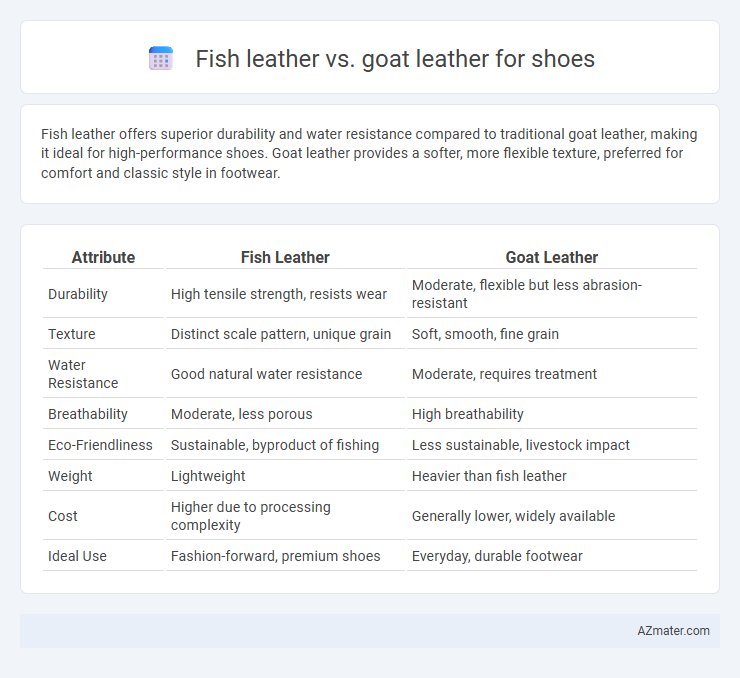Fish leather offers superior durability and water resistance compared to traditional goat leather, making it ideal for high-performance shoes. Goat leather provides a softer, more flexible texture, preferred for comfort and classic style in footwear.
Table of Comparison
| Attribute | Fish Leather | Goat Leather |
|---|---|---|
| Durability | High tensile strength, resists wear | Moderate, flexible but less abrasion-resistant |
| Texture | Distinct scale pattern, unique grain | Soft, smooth, fine grain |
| Water Resistance | Good natural water resistance | Moderate, requires treatment |
| Breathability | Moderate, less porous | High breathability |
| Eco-Friendliness | Sustainable, byproduct of fishing | Less sustainable, livestock impact |
| Weight | Lightweight | Heavier than fish leather |
| Cost | Higher due to processing complexity | Generally lower, widely available |
| Ideal Use | Fashion-forward, premium shoes | Everyday, durable footwear |
Introduction to Fish Leather and Goat Leather
Fish leather, derived primarily from species like salmon, cod, and perch, offers a unique texture and remarkable durability due to its dense fiber structure and natural water resistance, making it an innovative alternative in shoe manufacturing. Goat leather, known for its softness, flexibility, and breathable qualities, is traditionally favored for high-quality footwear because of its fine grain and resilience. Both materials present distinct advantages: fish leather stands out for its eco-friendly production and distinctive aesthetic, while goat leather excels in comfort and classic appeal.
Key Differences in Source and Production
Fish leather, sourced primarily from salmon, cod, and perch, involves a process of tanning fish skins that retains unique scale patterns and offers exceptional durability and water resistance. Goat leather, derived from goat hides, undergoes traditional tanning methods that emphasize soft texture, flexibility, and breathability, making it ideal for comfortable footwear. The production of fish leather requires specialized techniques to handle its thinner, more delicate skin, while goat leather processing benefits from established, widespread practices in the leather industry.
Texture and Appearance Comparison
Fish leather exhibits a distinctive scale pattern that adds a unique, textured appearance to shoes, often resulting in a glossy and intricate finish unlike the smoother, more uniform surface of goat leather. Goat leather is renowned for its soft, supple texture with a fine grain, providing a classic and elegant look suitable for high-end footwear. The natural variability in fish leather's texture offers a bold aesthetic, while goat leather maintains consistent appearance and durability, making each material preferable depending on design priorities.
Durability and Strength
Fish leather exhibits remarkable durability and strength due to its dense fiber structure, often surpassing goat leather in tear resistance and flexibility. Goat leather, known for its natural softness and lightweight properties, offers substantial strength but tends to be less resistant to abrasion compared to fish leather. For shoe manufacturing, fish leather provides enhanced longevity and resilience, making it ideal for high-wear footwear applications.
Breathability and Comfort
Fish leather offers superior breathability compared to goat leather due to its natural porous structure, enhancing moisture evaporation and reducing foot sweat. Goat leather remains a popular choice for comfort because of its soft texture and flexibility, but it may retain more heat during extended wear. For shoe applications prioritizing ventilation and a cooler foot environment, fish leather is an innovative alternative that improves breathability without sacrificing durability.
Sustainability and Environmental Impact
Fish leather offers a sustainable alternative to traditional goat leather by utilizing by-products from the fishing industry, reducing waste and minimizing the need for additional animal farming. Its production typically consumes less water and generates lower greenhouse gas emissions compared to goat leather, which involves livestock rearing with higher environmental footprints. Choosing fish leather for shoes supports eco-friendly practices by promoting resource efficiency and decreasing the overall environmental impact of leather goods.
Cost and Availability
Fish leather, made primarily from species like salmon or cod, tends to be more expensive and less readily available than goat leather due to specialized tanning processes and limited supply chains. Goat leather, widely sourced from regions with established livestock industries, offers a more consistent and affordable option in the shoe market. Cost differences stem from fish leather's novelty and the eco-friendly appeal, while goat leather benefits from mass production and durability for footwear.
Maintenance and Care Requirements
Fish leather requires gentle cleaning with a damp cloth and occasional conditioning to maintain its delicate scales and prevent drying or cracking, while goat leather demands regular moisturizing with leather conditioners to retain its soft, supple texture and resist wear. Fish leather's unique texture is more sensitive to harsh chemicals and excessive moisture, making maintenance less forgiving compared to the robust and more durable goat leather. Proper storage in a cool, dry place is essential for both to extend shoe lifespan and preserve their distinctive qualities.
Popular Shoe Applications
Fish leather, particularly from species like salmon and perch, is gaining popularity in the shoe industry for its unique texture and eco-friendly qualities, often used in fashion and casual footwear to create distinctive designs. Goat leather remains a traditional favorite in shoe manufacturing due to its durability, softness, and breathability, commonly applied in formal shoes, boots, and athletic footwear. Both materials offer versatility in design, with fish leather appealing to niche markets seeking sustainable and exotic options, while goat leather continues to dominate mainstream shoe applications.
Choosing the Best Leather for Your Shoes
Fish leather offers exceptional durability, natural water resistance, and a unique textured finish, making it an innovative choice for stylish, long-lasting shoes. Goat leather is prized for its softness, flexibility, and lightweight properties, providing superior comfort and breathability in footwear. When choosing the best leather for shoes, consider the balance between durability, aesthetic feel, and intended usage to match your lifestyle needs effectively.

Infographic: Fish leather vs Goat leather for Shoe
 azmater.com
azmater.com